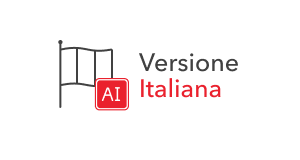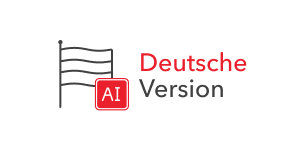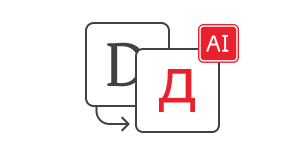AI translations - how does it work? How to assess the quality of translations?
Translations with the use of artificial intelligence AI, is not only a change in the field of text translation, but it is also part of a larger e-commerce revolution. In order to fully take advantage of its capabilities, it is worth understanding it a little. In this article, we will explain how AI translations are carried out in SOTE and how to prepare a store to ensure the best possible quality.
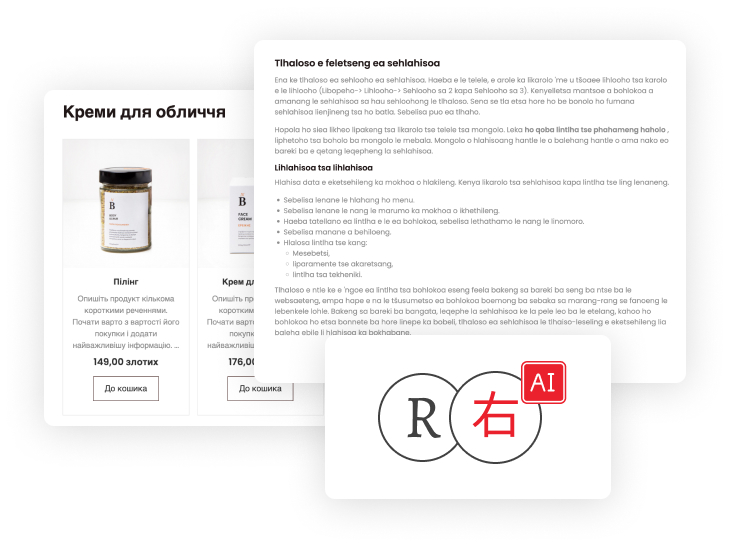
Translation of the store's offer using artificial intelligence (AI).
How do Open AI translations work according to the GPT Chat?
"OpenAI translations are based on advanced natural language processing technology. The main mechanism is the GPT (Generative Pre-trained Transformer) language model, which has been trained on a huge collection of texts in different languages. This model understands syntax, semantics, and the meaning of acquired language knowledge and is able to generate coherent translations from one language to another. Thanks to the enormous amount of training data, GPT can recognize context and idiomatic expressions, which translates into the quality of translations. "
AI translations - how does it work in practice?
After translating the first few thousand pages and over 30,000,000 characters, we have prepared a summary of the most important observations related to translating the offer of online stores using the example of SOTESHOP.
Automation of the translation process in 7 steps
The entire process, both translation and data updates in the store, is automated. In short, the process looks as follows:
- Estimating the cost of translation
- Downloading data from the store
- Performing the translation (the process takes about 1-3 days)
- Generating a translation quality verification report
- Automatic store update *)
- Verification of translations by the client and their corrections
- Automatic update of translations after verification
*) It is possible to preview the new language version without activating it in the store.
After the service is completed, the client receives a store with translated offers and data, and can immediately activate it for their customers.
The service does not include manual checking and entering of translations by SOTE. Our task is to automate the process and provide the client with the best data generated by AI.
Translation of descriptions
Good SEO, better translations.
In stores, the description is saved in HTML format. The more clear the description, the easier it is to translate. Similar rules apply here as in SEO, the simpler the better. Instead of using multiple colors, bolding, tables, icons, etc., it is better to write a few paragraphs of text, add a list of parameters, and separate longer text fragments with spaces. If the description has a logical structure, it is easier to translate and the system will generate correct results even for longer content.
HTML translations
In the Product Description Translation with OpenAI service, we offer translations of descriptions together with HTML code. This is a complicated process and requires advanced data analysis. Most AI systems have limitations on the number of characters of translated HTML text, around 2000 characters. If we subtract the HTML code characters, it may turn out that our text is only 500 characters, which is a very small limit.
At SOTE, we have designed a system that allows for HTML translation without this limitation, and translated HTML descriptions with 5000 or 10,000 characters are not a problem.
The system is able to accurately replicate descriptions, but when the HTML is too complicated, it may not be possible to translate the text together with HTML. In such a situation, the solution will be to translate the text without HTML.
There is also the possibility of preparing a custom function that will analyze the description and adjust the format of the description for translations. This is an individual service and is not included in the translation service.
Product names
Product names are the most difficult element of translation. This is a challenge not only for artificial intelligence, but also for translators who often have to seek advice from specialists or industry documents to determine the correct name. Below are some useful information that will help with translating product names and will also be useful for SEO:
- Longer product names, if possible descriptive e.g. instead of "Oil X100" it is better to use "Body oil X100"
- Names in one language e.g. in Polish, instead of in Polish and English at the same time.
- Phrases used in practice e.g. instead of "Dummy drone", it is better to use "Drone dummy".
- Names should not contain HTML code e.g. bolding, font changes, etc.
Translation quality assessment
These are general rules, but it is hard to imagine that someone will suddenly change all product names in the store. That is why we have developed a special product name verification system that allows for translation quality assessment. An independent AI module checks product name translations and generates a report of those records that require additional verification.
This is a unique system developed by SOTE and available only to our clients!
The strength of AI is not only its ability to perform translations, but also to check its results. It's getting interesting :)
Blog, Categories, Pages
Similarly to translating HTML names and descriptions, translations are generated for blogs, categories, category descriptions, web pages, and many other store elements. We constantly add new elements to translate all texts on the website. See the current list of translated elements in the service description: Translation of product descriptions with OpenAI
English and other languages
The best translation results are from English or to English. For translations, especially for specialized industries, it is recommended to translate the store into English and then from English to the target language. Therefore, if there is no English version of the store, it is necessary to add an English translation first.
Below is an interesting comparison of how well Open AI knows a given language for the language versions supported by SOTESHOP (GPT 3.5).
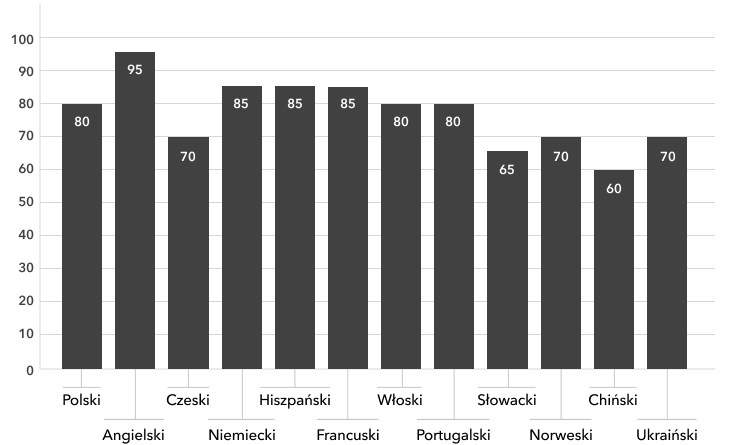
Explanation of values:
- 95 - Refers to English - the language in which the Open AI system was trained and understands very well at various levels, including many specialized and technical aspects.
- 80-85 - The system understands and generates texts from basic to advanced levels, but there may be limitations in more specialized contexts.
- 65-70 - The system understands and generates basic and intermediate level texts, but these skills may be limited in more specialized contexts.
- 60 - The system's abilities are limited to basic phrases and sentences, and there may be issues in more advanced or specialized contexts.
Other store elements
The basis for all translations in the online store are the system translations of the program. They apply to the user interface, text, and elements contained on standard store pages. Therefore, we perform AI translations for languages supported in SOTESHOP. If a language is not available in SOTESHOP, you can write to office@sote.pl with a request to add such a translation. If we decide to add a new language version, the client does not pay for the translation of texts in the standard version, but only for their own texts added to the store.
Summary
AI translations are becoming the standard and it is difficult to compete with them. These translations are getting better and even though they are not always perfect, using them gives a huge advantage in the e-commerce market. The right language in an online store is the first barrier for many customers and if we can easily, cheaply and quickly eliminate it with AI... it's simply worth it before our competition does it.
Translation of store offers using artificial intelligence (AI).
Related pages
